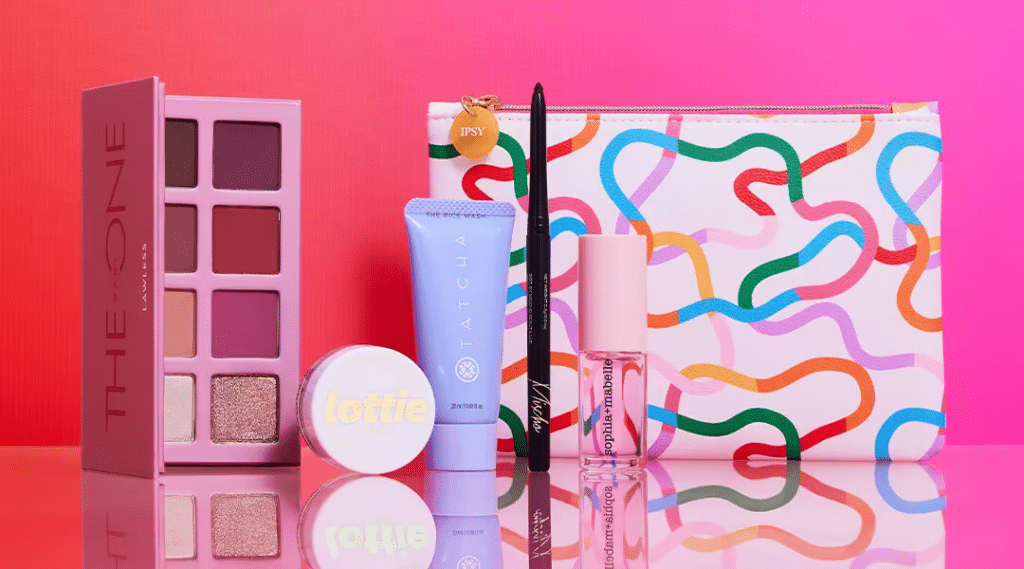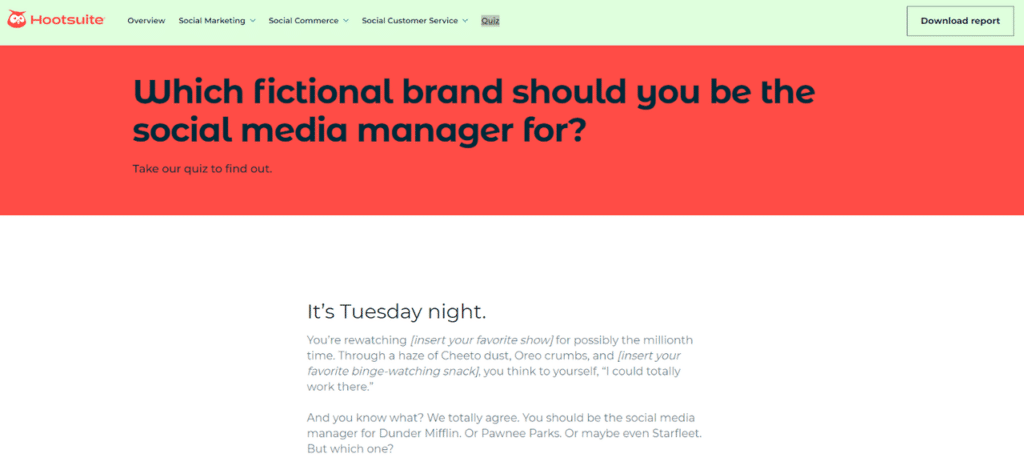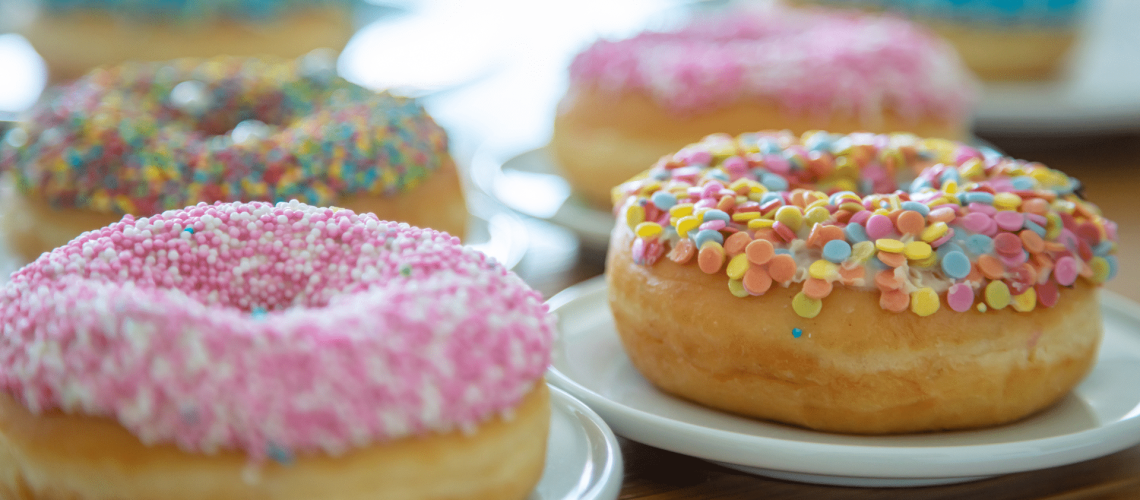You’re at the grocery store, checking all the standard “grown up” items off your list. Eggs? Check. Spinach? Check. Laundry detergent? Check. You’re nearing the checkout line when, out of the corner of your eye, something catches your attention. It’s a beautiful, gooey, freshly baked cookie. Yeah, maybe you don’t need it. But life is hard, and, let’s face it: you deserve a little treat.
Sound familiar? You’re not alone. In fact, 62% of Millennials and Gen Zs reported “treating themselves” more now than ever before. This growing, TikTok-fueled trend, dubbed “treat culture,” is all about embracing life’s little indulgences as a source of self-care and happiness. And it’s not just about satisfying your sweet tooth – treat culture encompasses everything from skincare routines to cozy movie nights in to saving yourself time to do the things you love. When we peel back the wrapper, treat culture is all about relishing the joy and empowerment of taking care of yourself.
As a marketer, you might be wondering how you can leverage this self-care mentality and create content that resonates with your audience’s craving for little treats. Let’s dig in to the world of treat culture so you can infuse your content marketing with a generous helping of indulgence.
What’s in a treat?
In case the algorithm hasn’t exposed you to TreatTok, you may be wondering: What exactly is treat culture? In a nutshell, it’s the act of indulging in small pleasures, or “little treats”, as a form of self-care. Whether it’s a reward for a job well done, a pick-me-up after a tough day, or simply because you feel like it, treat culture is all about savoring life’s little joys.
Although we’ve seen iterations of this in the past – like the Lipstick Index or the cultural obsession with Millennials and avocado toast – treat culture has garnered a ton of attention lately. Economic challenges have made big-ticket purchases and long-term investments less attainable for many Millennials and Gen Zs. In response, they’re turning to smaller, more accessible ways to treat themselves. There’s also a psychological component at play: instant gratification and dopamine release can provide a much-needed coping mechanism for stress and uncertainty.
As a result, the self-care market is expanding beyond expensive, time-consuming rituals to include everyday indulgences. In fact, in 2022, snack sales in the U.S. reached a whopping $181 billion, reflecting an 11% increase driven by the growing interest in treating oneself to small luxuries.
Tapping into your treats
But the snack industry isn’t the only one that can seize the mentality created by treat culture. In fact, businesses in virtually every industry can frame their product as adding little joys to their audience’s everyday lives. When you boil it down, treat culture can be found in any aspect of your business that evokes positive emotions. Whether it be joy, stress relief, excitement, anticipation, or camaraderie, you want to highlight the features of your product or service that improve the lives of those that use it.
To pin down the luxury of your business’s offerings, start by asking yourself: why did I create this in the first place? What was I hoping to solve, and why? You know better than anyone that what you’re offering makes people’s lives better, because that’s why you brought it to life. Once you get an idea of the big picture, take a closer look at the specific aspects of your product or service that could be positioned as a source of little luxuries, whether it’s through your product features, educational content, or customer success stories.
To dig a bit deeper, emphasize how people can use your offering to take control and rely on themselves. Instill in them the confidence to use your offering to enhance and spotlight the expertise they already have. Maybe your offering makes their goals more achievable, allowing them to showcase more accomplishments. Or maybe your offering streamlines their responsibilities so they have more time in their schedule to devote to the things they love.
By emphasizing these “treat” aspects in your content, you can help your audience view your brand in a positive light, creating more confidence and adding a hint of indulgence to their day-to-day responsibilities.
Marketing your own “little treats”
So, how can you leverage treat culture in your content marketing? The key is to position your products or services as small indulgences that can brighten your audience’s day or provide a moment of joy. Look for ways to showcase how your offerings fit into the treat culture narrative, whether it’s through visual content, storytelling, or interactive experiences. Here are some ideas:
Showcase real people
User-generated content is a powerful way to recognize your audience’s desire to treat themselves. Feature customers and influencers that align with your brand values enjoying your products as a little treat. By showing how real people benefit from what you offer, you create authentic, relatable content that resonates with your audience. Encourage your customers to share their treat experiences by telling the stories of how your product has impacted their lives. By sharing these stories, you build a sense of community and inspire others to indulge.
Skincare brand Versed works with beauty bloggers and lifestyle influencers to demonstrate how their products transform an ordinary evening into much needed “me-time”. This emphasis on attainable de-stressors makes their content relatable and authentic, resonating with their audience’s desire to prioritize their well-being without going to a fancy spa.
FabFitFun showcases lots of UGC boasting about the subscription service’s personalized self-care goodies, like in the video below. Not only does she show off the products she chose herself, but she also capitalizes on the popular “Girl Math” meme, offering ways you can spend the money you save on ultra-discounted products.
Sharing UGC is especially powerful for brands promising their customers productivity and saved time. For busy professionals, these solutions are the difference between spending their night on hobbies or catching up with loved ones, and burning the midnight oil on tedious tasks. Emphasize that your offering gives them the time and energy to prioritize non-work aspects of their lives, freeing up space for all the people and activities that make them a whole person.
This glowing testimonial for productivity app Motion calls attention to the software’s ability to carve out time for both her professional responsibilities and all the extra things she loves to do, like baking and reading. This showcases how Motion helps the creator balance all the important components of her life, not just her work, framing saved time as a treat that allows for indulgence in beloved hobbies
Leverage the element of surprise
As fun as it is to treat yourself, sometimes you want the treat to come to you unexpectedly. Brands can tap into this by incorporating delightful surprises into their marketing strategies. When customers receive an unexpected treat, it sparks a sense of joy and excitement that goes beyond the satisfaction of a planned indulgence. Surprise treats take the responsibility of self-care off the customer’s shoulders, making them feel genuinely cared for and appreciated by your brand. By occasionally delighting your audience with unanticipated little luxuries, you create memorable moments that strengthen their emotional connection to your brand.
Ipsy, a beauty subscription service, surprises its customers each month with a curated selection of makeup, skincare, and hair care products. The element of surprise is a key part of the Ipsy experience, as subscribers eagerly anticipate the arrival of their Glam Bags, not knowing exactly which products they’ll receive. This monthly surprise treat seizes the excitement of discovering new beauty indulgences, making customers feel pampered and cared for by the brand.

Surprising your customers with small, tangible treats like stickers, fridge magnets, or other branded swag can go a long way in sparking joy and creating a lasting impression. These unexpected extras, when included with a purchase or sent as a standalone surprise, make customers feel valued and appreciated. A small gesture like a fun sticker pack or a quirky fridge magnet can brighten someone’s day and create a positive association with your brand. Bonus points if the swag you send out is specific to your industry, like a bedding company sending out branded slippers and sleep masks to distributors.
Surprises don’t always have to be physical . Digital treats can be just as exciting, and they’re a bit more achievable for smaller companies with limited budgets or manpower. For example, a marketing company could surprise its clients by sending out a set of fun, branded Zoom backgrounds for them to use in their virtual meetings. This unexpected treat in their inbox not only brings a smile to the clients’ faces but also shows that the company understands their daily challenges and wants to make their remote work experience a little more enjoyable. Plus, it’s a clever way to extend your brand’s presence into their virtual workspaces.
Make it personal
Gamifying or adding interactive elements to your campaigns can be a delightful way to engage your audience and create “brain treats.” By incorporating fun quizzes, challenges, or personalized experiences, you transform passive content consumption into a fun, memorable interaction with your brand. These interactive elements evoke the treat culture mentality by providing moments of joy, surprise, and intellectual stimulation. Gamification encourages users to invest time and effort into engaging with your content, making the experience feel like a rewarding little treat for their minds.
To add an element of fun while showcasing their expertise, Hootsuite created a knowledge quiz based on its annual social media trends report. Users were incentivized to read the report and take the quiz by offering discounts on Hootsuite’s products. This game is a win-win-win, both educating readers and giving them the sense of satisfaction when they get their results, all while generating leads for Hootsuite’s product promotion.

On top of gamification, adding a personal touch to your offerings can be a powerful way to create stronger emotional ties with your audience. By tailoring products or experiences to each user’s preferences or allowing them to add their own flair, you make them feel seen, understood, and cared for by your brand. Personalization makes each interaction feel like a special little indulgence crafted just for them.
Take Spotify Wrapped, for example. Every year, Spotify surprises users with a personalized snapshot of their listening habits, complete with their top songs, artists, and genres. These personalized little treats not only delight users by catering to their individual tastes but also keep them coming back to the platform to discover their next favorite tune.

Spotlight the season
Positioning your brand within the excitement and anticipation surrounding seasons, holidays, and special occasions is another great way to leverage treat culture in your content marketing. By creating a sense of urgency around limited-time offerings or seasonal experiences, you can encourage your audience to indulge in a little treat before it’s gone. This adds a sense of urgency, playing into the idea that this treat is a fleeting opportunity to be seized in the moment.
Seasonal content also helps your brand stay relevant and top-of-mind, as you become associated with the joys and traditions that arrive throughout the year. Aligning your treats with the unique themes and emotions of different seasons allows you to create a deeper, more memorable connection with your audience.
Bath and Body Works, famous for their seasonal scents, ushered in the the holiday spirit on November 1 with a video featuring the transition from Autumn (AKA pumpkin spice season) and Winter. The display of their seasonal holiday products among festive Christmas decor builds anticipation and excitement, driving customers to get their hands on limited edition scents that will get them in the holiday spirit.
Businesses not offering tangible goods can still tap into seasonal excitements and stressors their audience may be experiencing. Consider what issues or upcoming events may be approaching for your clients, and offer authentic, human solutions to common pain points.
For example, a financial services firm could share a blog post with ideas for affordable, morale-boosting treats for accounting professionals during tax season, like desk yoga or a special coffee blend. Although these tips don’t directly impact your bottom line, offering people solutions to relatable stressors positions your brand as empathetic and relatable.
Industry-specific events, like major trade shows and conferences, offer unique opportunities to create timely, relevant content that resonates with your audience. These tentpole moments allow you build on the excitement, challenges, or trends that come with these pivotal times, positioning your brand as a go-to source for the latest industry insights and experiences.
For example, in the tech world, major conferences like CES generate a lot of buzz and anticipation. Tech companies can create content such as blog posts highlighting the innovations they’re looking forward to seeing, polls asking followers what they’re most excited about, real-time updates, and behind-the-scenes peeks during the event. By doing so, brands can keep themselves top-of-mind during a busy time in their industry while providing valuable content to their audience.
The cherry on top
As you start sprinkling treat culture into your content marketing, it’s important to keep some best practices in mind:
- Maintain authenticity and relevance. Ensure your treat-focused content aligns with your brand identity and values, and tailor your approach to your specific audience and industry.
- Balance indulgence with responsibility. Promote treats in moderation and within the context of overall well-being. Avoid encouraging excessive consumerism or unhealthy habits.
- Monitor and adapt to treat culture trends. Stay attuned to evolving consumer preferences and cultural shifts, and continuously refine your marketing strategies based on performance and feedback.
Whether you’re showcasing your products as indulgent must-haves or finding creative ways to infuse “little treat” moments into your industry-specific content, aligning your brand with this growing trend can help you connect with your audience on a deeper, more emotional level. By appealing to the universal desire for little luxuries and moments of joy, you can create content that positions your brand as a source of everyday indulgence.
Treat culture is all about celebrating life’s simple pleasures and self reliance. By embracing this mentality in your marketing strategy, you can foster a stronger sense of loyalty and engagement among your customers. So go ahead: treat your audience to content that makes them feel special, appreciated, and deserving of a little extra TLC – and watch as your brand becomes their go-to destination for their daily pick-me-up.

